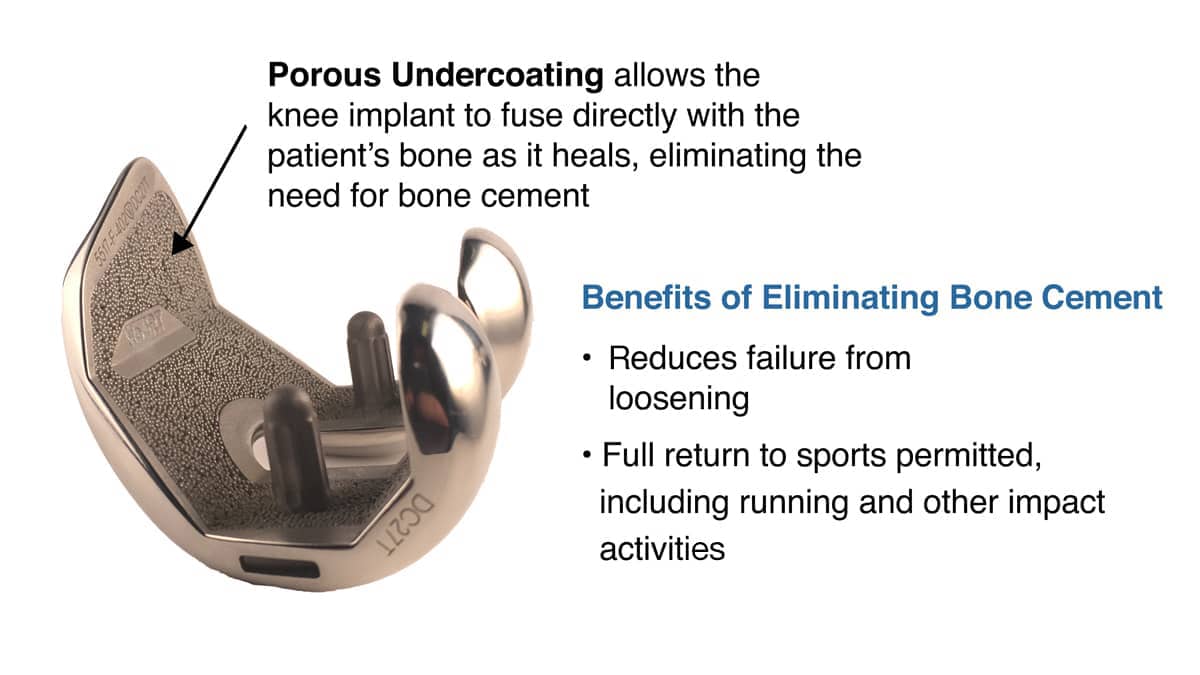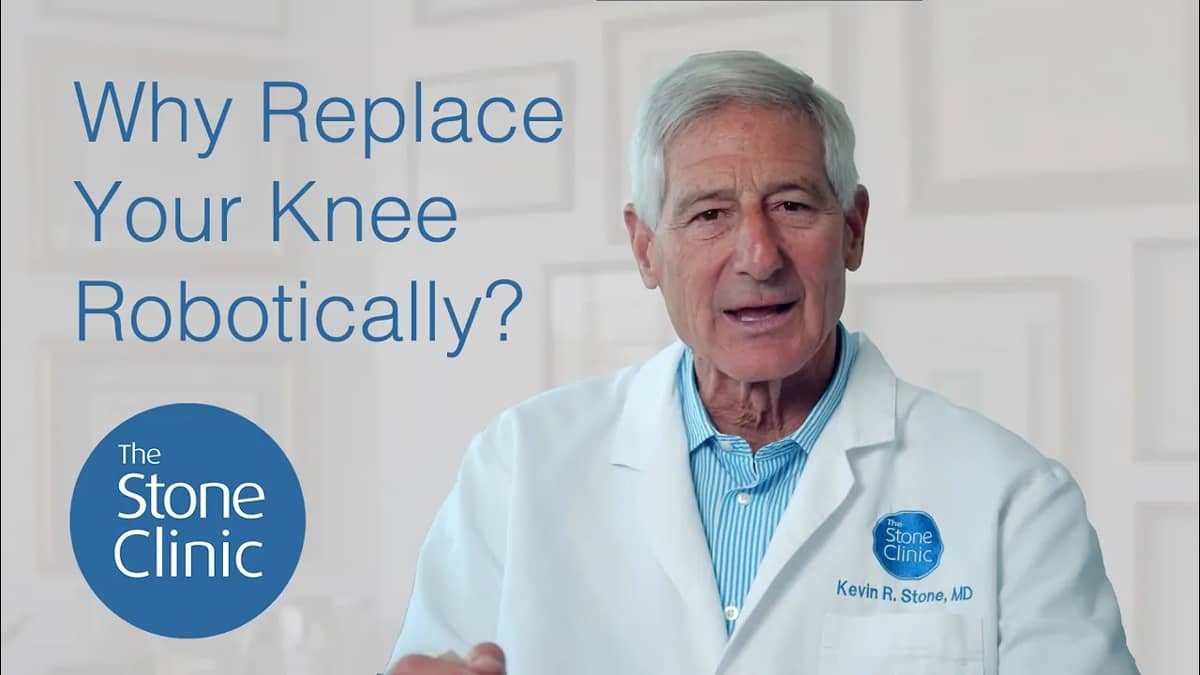Total Knee Replacement for Athletes
Hear From Our Patients
Back to Skiing on a Total Knee ReplacementAfter a total knee replacement, is it possible to get back to sport? Yes. Here is why it is important that you do.

Knee Replacement Should Help Athletes Become More Active
Despite what you may have been told, total knee replacement should actually help athletes become more active.
The traditional advice with total knee replacement has been: “Wait for your knee pain to get unbearable. Wait until you are older." And, "once you have the total joint replacement: Don’t exercise too much. And don’t run!”
The fear behind those statements was that the joint replacement might loosen over time or wear out.
The current advice we give at our clinic: “Every year is precious. When possible, use biologic knee replacement procedures —such as articular cartilage paste grafting, combined with meniscus replacement—to rebuild the knee naturally. If you have bone-on-bone disease, past the point where biologic replacement techniques can work, replace the affected area with artificial components. And replace only the part that is worn out, usually with a robotic partial knee replacement.”
Choosing the Best Knee Replacement Implant for Athletes
We only recommend a full knee replacement if the joint is worn on all sides, is severely misaligned, or has other complicating factors—and even then, we typically do not replace the patella. When we do perform a knee replacement, we use uncemented components specially designed to fuse directly with bone. Thanks to highly precise robotic guidance, we can use this cement-free approach in more than 95% of our joint replacements, eliminating the need for bone cement altogether.

The traditional cause of artificial joint replacement failures, in the absence of infection, is most commonly the loosening of the cement from the bone interface1, and the wearing out of the plastic inserts. Much of this observed loosening was due to the weakening of the bone (osteoporosis) as patients age and decrease their activities. But the only known effective way to build bone is by resistance exercise.
Therefore, by increasing your weightlifting, cycling, skiing, and hiking, you decrease the chance of the component loosening by strengthening the bone2. Additionally, the stronger the muscles are, the less force goes through the joint. Muscle absorbs force, guides more normal mechanics, and protects the joint. Increasing weightlifting increases muscle size more than any other activity.
So it is possible that the advice to limit activity after a cemented knee replacement may have actually increased failure rates.
Dr. Stone explains why it's important to build muscle after a joint replacement
How to Safely Return to Sports and Activity After Knee Replacement
Since we usually do not use cement at our clinic, our patients do not have that worry. After your knee replacement, our advice is to exercise more than you have in years. Focus on total-body muscle building and weight optimization. You can likely return to most sports when you are fit enough to protect your joints.
Another concern has been the wearing out of plastic components. This most often occurs due to malposition or poor tracking of the joint. Today, tracking has been dramatically improved by the computer-guided accuracy of joint replacement. Tracking also improves through strong muscles, better balance, and a more normal gait—achieved by building a strong core and strong trunk muscles. And since most modern knee replacements have highly durable (and interchangeable) plastic trays, why limit a lifetime of sports by the fear of them wearing out?
Why It’s Safe to Run After Knee Replacement
Which brings us to running. Running is the most common concern we hear from our athletes who need total knee replacements.
The data shows that whether you run a mile or walk a mile, the total force on the joint is the same. The peak forces vary depending on the running surface, the smoothness of the gait, shoe wear, and other factors. So if you choose to run, run with great form on soft surfaces with new, shock-absorbing running shoes. (Cycling is a more logical sport, as it limits the impact factor—but logic is not the reason we run.) In my years of practice, I have never seen a total knee become worn out from running, nor have any of my peers.
To sum up: If you have been told you need a total knee replacement, first check the options and make sure you really do need one. If you end up getting a total knee replacement, it need not be the end of your active life. Use it as an excuse to become fitter, faster, and stronger than you have been in years.
Total body fitness conditioning is the key to a long-lasting joint replacement. So get back to your exercise, work on building muscle, and enjoy your freedom to move. While you may no longer be “all-natural,” your bionic self may surprise you.
Article originally published April 15, 2015. Updated & republished July 26, 2020 by Kevin R. Stone, MD with scientific and content updates.
80% of patients who are told they need a total knee replacement, don't need one. Our BioKnee® program biologically reconstructs the knee joint without the use of artificial implants. Head here to learn about our alternative to knee replacement.
References
1 Hampton, C. B., Berliner, Z. P., Nguyen, J. T., Mendez, L., Smith, S. S., Joseph, A. D., Padgett, D. E., & Rodriguez, J. A. (2020). Aseptic Loosening at the Tibia in Total Knee Arthroplasty: A Function of Cement Mantle Quality?. The Journal of arthroplasty, 35(6S), S190–S196. https://doi.org/10.1016/j.arth.2020.02.028
2 Hong, A. R., & Kim, S. W. (2018). Effects of Resistance Exercise on Bone Health. Endocrinology and metabolism (Seoul, Korea), 33(4), 435–444. https://doi.org/10.3803/EnM.2018.33.4.435
The Cementless Knee Replacement for Athletes Explained
Learn how recent advancements in robotic-assisted surgery technology give Dr. Stone unparalleled accuracy in placing knee replacement implants; allowing for a quicker recovery time, better range of motion, less pain medication, and greater durability for demanding activities—including running.



